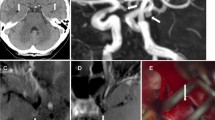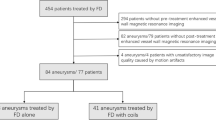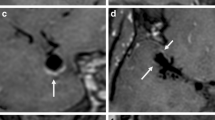Abstract
Purpose
Wall enhancement of saccular cerebral aneurysms has not been researched sufficiently. Our purpose of this study was to investigate the incidence of aneurysmal wall enhancement by the three-dimensional turbo spin-echo sequence with motion-sensitized driven equilibrium (MSDE-3D-TSE) imaging after gadolinium injection.
Methods
We retrospectively reviewed the pre- and postcontrast MSDE-3D-TSE images of 117 consecutive patients with intracranial aneurysms from September 2011 to July 2013. A total of 61 ruptured and 83 unruptured aneurysms of 61 patients with subarachnoid hemorrhage (SAH) and 56 non-SAH patients were enrolled in this study. We evaluated the wall enhancement of each aneurysm on postcontrast MSDE-3D-TSE images compared with precontrast images. We classified the aneurysmal wall enhancement into three groups as “Strong enhancement,” “Faint enhancement,” and “No enhancement.”
Results
“Strong/Faint enhancement” of the aneurysm was detected in 73.8/24.6 % of the ruptured aneurysms and 4.8/13.3 % of the unruptured aneurysms. “No enhancement” was found in 1.6 % of the ruptured aneurysms and 81.9 % of the unruptured aneurysms.
Conclusions
By magnetic resonance vessel wall imaging using the MSDE-3D-TSE sequence, wall enhancement was frequently observed on ruptured aneurysms. Therefore, aneurysmal wall enhancement may be an indicator of the ruptured condition, which is useful information for managing patients with SAH.





Similar content being viewed by others
References
Matouk CC, Mandell DM, Günel M, Bulsara KR, Malhotra A, Hebert R, Johnson MH, Mikulis DJ, Minja FJ. Vessel wall magnetic resonance imaging identifies the site of rupture in patients with multiple intracranial aneurysms: proof of principle. Neurosurgery. 2013;72:492–6.
Wang J, Yarnykh VL, Hatsukami T, Chu B, Balu N, Yuan C. Improved suppression of plaque-mimicking artifacts in black-blood carotid atherosclerosis imaging using a multislice motion-sensitized driven-equilibrium (MSDE) turbo spin-echo (TSE) sequence. Magn Reson Med. 2007:58;973–81.
Nagao E, Yoshiura T, Hiwatashi A, Obara M, Yamashita K, Kamano H, Takayama Y, Kobayashi K, Honda H. 3D turbo spin-echo sequence with motion-sensitized driven-equilibrium preparation for detection of brain metastases on 3T MRI imaging. AJNR Am J Neuroradiol. 2011;32:664–70.
Schubiger O, Valavanis A, Hayek J. Computed tomography in cerebral aneurysms with special emphasis on giant intracranial aneurysms. J Comput Assist Tomogr. 1980;4:24–32.
Nagahiro S, Takada A, Goto S, Kai Y, Ushio Y. Thrombosed growing giant aneurysms of the vertebral artery: growth mechanism and management. J Neurosurg. 1995;82:796–801.
Abe T, Hagihara N, Hirohata M, Uchiyama Y, Tanaka N, Hayabuchi N. Partially thrombosed vertebral artery aneurysm with wall enhancement treated by stent-assisted coil embolization. Neurol Med Chir (Tokyo). 2011;51:431–3.
Nakatomi H, Segawa H, Kurata A, Shiokawa Y, Nagata K, Kamiyama H, Ueki K, Kirino T. Clinicopathological study of intracranial fusiform and dolichoectatic aneurysms: insight on the mechanism of growth. Stroke. 2000;31:896–900.
Nehls DG, Flom RA, Carter LP, Spetzler RF. Multiple intracranial aneurysms: determining the site of rupture. J Neurosurg. 1985;63:342–8.
Hackney DB, Lesnick JE, Zimmerman RA, Grossman RI, Goldberg HI, Bilaniuk LT. MR identification of bleeding site in subarachnoid hemorrhage with multiple intracranial aneurysms. J Comput Assist Tomogr. 1986;10:878–80.
Aoki S, Shirouzu I, Sasaki Y, Okubo T, Hayashi N, Machida T, Hoshi E, Suzuki K, Funada N, Araki T, Sasaki Y. Enhancement of the intracranial arterial wall at MR imaging: relationship to cerebral atherosclerosis. Radiology. 1995;194:477–81.
Kataoka K, Taneda M, Asai T, Kinoshita A, Ito M, Kuroda R. Structural fragility and inflammatory response of ruptured cerebral aneurysms: a comparative study between ruptured and unruptured cerebral aneurysms. Stroke. 1999;30:1396–1401.
Frösen J, Piippo A, Paetau A, Kangasniemi M, Niemelä M, Hernesniemi J, Jääskeläinen J. Remodeling of saccular cerebral artery aneurysm wall is associated with rupture: histological analysis of 24 unruptured and 42 ruptured cases. Stroke. 2004;35:2287–93.
Swartz RH, Bhuta SS, Farb RI, Agid R, Willinsky RA, terBrugge KG, Butany J, Wasserman BA, Johnstone DM, Silver FL, Mikulis DJ. Intracranial arterial wall imaging using high-resolution 3-tesla contrast-enhanced MRI. Neurology. 2009;72:627–34.
Inoue T, Shimizu H, Fujimura M, Saito A, Tominaga T. Annual rupture risk of growing unruptured cerebral aneurysms detected by magnetic resonance angiography. J Neurosurg. 2012;117:20–5.
The UCAS Japan Investigators. The natural course of unruptured cerebral aneurysms in a Japanese cohort. N Engl J Med. 2012;366:2474–82.
Sonobe M, Yamazaki T, Yonekura M, Kikuchi H. Small unruptured intracranial aneurysm verification study: SUAVe study, Japan. Stroke. 2010;41:1969–77.
International Study of Unruptured Intracranial Aneurysms Investigators. Unruptured intracranial aneurysms: natural history, clinical outcome, and risks of surgical and endovascular treatment. Lancet. 2003;362:103–10.
Acknowledgments
The authors would like to thank Dr. Paul Hollister for the English editing of the manuscript.
Ethical Standards and Patient Consent
The authors declare that all human and animal studies have been approved by the ethical committee of their hospital and have therefore been performed in accordance with the ethical standards laid down in the 1964 Declaration of Helsinki and its later amendments. The authors also declare that all patients gave informed consent prior to inclusion in this study.
Conflict of interest
M. Obara is an employee of Philips Electronics Japan, Ltd.
Author information
Authors and Affiliations
Corresponding author
Rights and permissions
About this article
Cite this article
Nagahata, S., Nagahata, M., Obara, M. et al. Wall Enhancement of the Intracranial Aneurysms Revealed by Magnetic Resonance Vessel Wall Imaging Using Three-Dimensional Turbo Spin-Echo Sequence with Motion-Sensitized Driven-Equilibrium: A Sign of Ruptured Aneurysm?. Clin Neuroradiol 26, 277–283 (2016). https://doi.org/10.1007/s00062-014-0353-z
Received:
Accepted:
Published:
Issue Date:
DOI: https://doi.org/10.1007/s00062-014-0353-z




